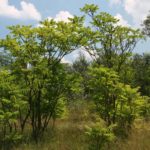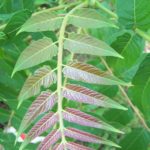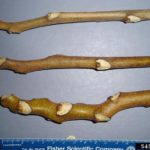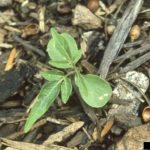Gallery:
- Tree of Heaven
- Tree of Heaven Leaf
- Tree of Heaven Flower Cluster. Photo by: Leslie J. Mehrhoff, University of Connecticut, Bugwood.org
- Tree of heaven twigs
- Tree of Heaven Twig
- Tree of Heaven Seedling
Common names:
tree of heaven, stinking quassia, copal-tree, China-sumac, varnish tree
Scientific Name:
Ailanthus altissima
Description:
Tree of heaven is a fast-growing deciduous tree in the Simaroubaceae family. Its leaves are compound and alternate with anywhere from 10 to 45 leaflets. Flowers grow in large clusters and are light green to yellow. Each seed is encased in a slightly twisted papery wing. The bark on young branches is yellow-brown, while older bark is gray. The tree has a foul odor, reminiscent of rancid peanut butter.
Life cycle:
Height of mature plants
25-50 feet
Flower color:
Light green to yellow
Bloom time:
May – June
Look-a-likes:
Tree of Heaven is sometimes mistaken for sumac, walnut, or hickory. Two of its distinguishing features are the prominent leaf scars on the twigs and the foul peanut butter odor.
Habitat:
Tree of heaven grows in many habitat types, though it prefers sunny disturbed areas. It can invade roadsides, forest edges, woodlands, fields, urban parks, and riparian areas. It can grow in disturbed areas with poor soils, and can sometimes be found growing in cement cracks.
Impacts:
Tree-of-heaven creates problems in natural systems by forming large thickets via root suckering. Riparian areas are especially affected. Western Oregon populations invade road rights-of-way, parks, and private property. Its growth outpaces many native trees, which reduces the biodiversity of important habitats. Lateral rooting can push up pavement and sidewalks and has been noted to ruin septic tank drain fields in its search for moisture. It produces large numbers of seeds and vigorously resprouts after cutting, making control difficult. Herbicide applications, while the tree is leafed out, have been minimally successful.
Noxious Weed Listing:
- WeedWise: Status Maintenance
- State of Oregon: Class B
- State of Washington: Class C
- Four County CWMA: Class B
- Columbia Gorge CWMA: Class C
Origin:
China and Taiwan
Links:
Oregon Noxious Weed Profile
Washington Noxious Weed Profile
Invasive.org profile
CABI Invasive Species Compendium
Global Invasive Species Database






